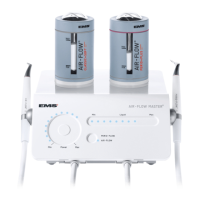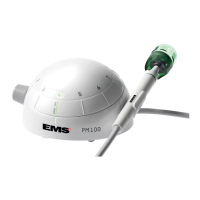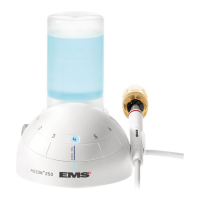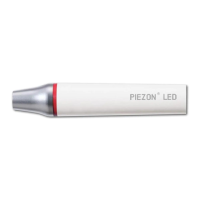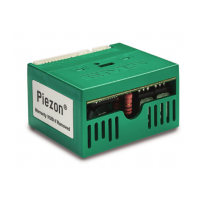26 27
Proximity elds from RF wireless communications equipment
IEC 61000-4-3
Test
Frequency
(MHz)
Band
(MHz)
Service Modulation
Maximum power
(W)
Distance
(m)
Immunity test
level
(V/m)
385 380-390 TETRA 400
Pulse Modulation
18Hz
1,8 0,3 27
450 430-470
GMRS 460,
FRS 460
FM
±5 kHz deviation
1 kHz sine
2 0,3 28
710
745
780
704-787 LTE Band 13, 17
Pulse
Modulation
217 Hz
0,2 0,3 9
810
870
930
800-960
GSM 800/900,
TETRA 800,
iDEN 820, CDMA
850, LTE Band 5
Pulse
Modulation
18 Hz
2 0,3 28
1720
1845
1970
1700-1990
GSM 1800, CDMA
1900,
GSM 1900, DECT,
LTE Band 1, 3, 4,
25, UMTS
Pulse
Modulation
217 Hz
2 0,3 28
2450 2400-2570
Bluetooth, WLAN,
802.11b/g/n, RFID
2450,
LTE Band 7
Pulse
Modulation
217 Hz
2 0,3 28
5240
5500
5785
5100-5800 WLAN 802.11a/n
Pulse
Modulation
217 Hz
0,2 0,3 9
NOTE: This equipment has been tested and found to comply with the limits for a Class B digital device, pursuant to part 15 of the FCC
Rules. These limits are designed to provide reasonable protection against harmful interference in a residential installation. This equipment
generates, uses and can radiate radio frequency energy and, if not installed and used in accordance with the instruction, may cause harmful
interference to radio communications. However, there is no guarantee that interference will not occur in a particular installation. If this
equipment does cause harmful interference to radio or television reception which can be determined by turning the equipment off and on,
the user is encouraged to try to correct interference by one or more of the following measures:
- Reorient or relocate the receiving antenna.
- Increase the separation between the equipment and receiver.
- Connect the equipment into an outlet on a circuit different from that to which the receiver is connected.
- Consult the dealer or an experienced radio/TV technician for help.
Electromagnetic emissions compliance
Emissions test Compliance Electromagnetic environment - guidance
RF emissions CISPR 11 Group 1 The product uses RF energy only for its internal function. Therefore, its
RF emissions are very low and are not likely to cause any interference in
nearby electronic equipment.
RF emissions CISPR 11 Class B
The product is suitable for use in all establishments, including domestic
establishments and those directly connected to the public low-voltage
power supply network that supplies buildings used for domestic purposes.
Harmonic emissions IEC 61000-3-2 Class A
Voltage fluctuations / flicker emissions
IEC 61000-3-3
Complies
ELECTROMAGNETIC COMPATIBILITY
The use of parts other than those supplied or listed as accessory may negatively affect EMC performance.
The device has embedded a low power, 8 dBm EIRP max, Bluetooth
®
2.4 GHz module, for communication with the wireless
pedal. This radio module is disabled when a wired pedal is connected (device reboot required).
The Bluetooth module complies with all the restrictions foreseen by the ERC recommendations 70-03 for the CEPT countries
concerning the Annex 3 (Wideband Data Transmission System band A 2400-2483.5 MHz) without requiring any modifications
of the products by the user.
The product is intended for use and Basic Safety is maintained in the electromagnetic environment specified below.
The customer or the user of this product should assure that it is used in such an environment.
Electromagnetic immunity compliance
Immunity test IEC 60601 test level Compliance level Electromagnetic environment - guidance
Electrostatic discharge (ESD)
IEC 61000-4-2
± 8 kV contact
± 15 kV air
Floors should be wood, concrete or
ceramic tile. If floors are covered with
synthetic material, relative humidity should
be > 30%.
Electrical fast transient/burst
IEC 61000-4-4
± 2 kV for power supply lines 100 kHz repetition
frequency
± 1 kV for input/output lines 100 kHz repetition frequency
Mains power quality should be that
of a typical commercial or hospital
environment.
Surge
IEC 61000-4-5
± 1 kV line(s) to line(s)
± 2 kV line(s) to earth
Mains power quality should be that
of a typical commercial or hospital
environment.
Voltage dips
IEC 61000-4-11
Voltage interruptions
IEC 61000-4-11
<5 % UT (>95 % dip in UT) for 0,5 cycle
40 % UT (60 % dip in UT) for 5 cycles
70 % UT (30 % dip in UT) for 25 cycles
0 % UT for 0,5 cycle at 0°, 45°, 90°, 135°, 180°, 225°, 270°
and 315°
0 % UT for 1 cycle single phase
<5 % UT (>95 % dip in UT) for 5 s
0% UT for 250 cycles
Mains power quality should be that
of a typical commercial or hospital
environment. If the user of the product
requires continued operation during power
mains interruptions, it is recommended
that the product be powered from an
uninterruptible power supply or a battery.
Power frequency (50/60 Hz)
magnetic field
IEC 61000-4-8
30 A/m 30 A/m (50 Hz or 60 Hz) Power frequency magnetic fields should
be at levels characteristic of a typical
location in a typical commercial or hospital
environment.
Conducted RF
IEC 61000-4-6
Radiated RF
IEC 61000-4-3
Proximity fields from RF
wireless communications
equipment
IEC 61000-4-3
3 V
150 kHz to 80 MHz
6V in ISM bands 150kHz
and 80 MHz
80 % AM at 1 kHz
3 V/m
80 MHz to 2.7 GHz
80% AM at 1 kHz
See Table below
3 V
150 kHz to 80 MHz
6V in ISM bands 150kHz
and 80 MHz
80 % AM at 1 kHz
3 V/m
80 MHz to 2.7 GHz
80% AM at 1 kHz
Portable RF communications equipment
(including peripherals such as antenna
cables and external antennas) should be
used no closer than 30 cm (12 inches) to
any part of the AIRFLOW
®
ONE, including
its cables. Otherwise, degradation of
the performance of this equipment
could result.Field strengths from fixed
RF transmitters, as determined by an
electromagnetic site survey
20
, should be
less than the compliance level in each
frequency range
21
.
Interference may occur in the vicinity of
equipment marked with the following
symbol:
or
IEC 61000-4-39 134.2 kHz / Modulation
pulsée 2.1 kHz / 65A/m
13.56 kHz / Modulation
pulsée 50 kHz / 7.5A/m
134.2 kHz / Modulation
pulsée 2.1 kHz / 65A/m
13.56 kHz / Modulation
pulsée 50 kHz / 7.5A/m
Notes:
- UT is the a. c. mains voltage prior to application of the test level.
- At 80 MHz and 800 MHz, the higher frequency range applies.
- These guidelines may not apply in all situations. Electromagnetic propagation is affected by absorption and reflection from
structures, objects and people.
20 Field strengths from xed transmitters, such as base stations for radio (cellular/cordless) telephones and land mobile radios, amateur radio, AM and FM
radio broadcast and TV broadcast cannot be predicted theoretically with accuracy. To assess the electromagnetic environment due to xed RF transmitters, an
electromagnetic site survey should be considered. If the measured eld strength in the location in which the product is used exceeds the applicable RF compliance
level above, the product should be observed to verify normal operation. If abnormal performance is observed, additional measures may be necessary, such as re-
orienting or relocating the product.
21 Over the frequency range 150 kHz to 80 MHz, eld strengths should be less than 3 V/m.

